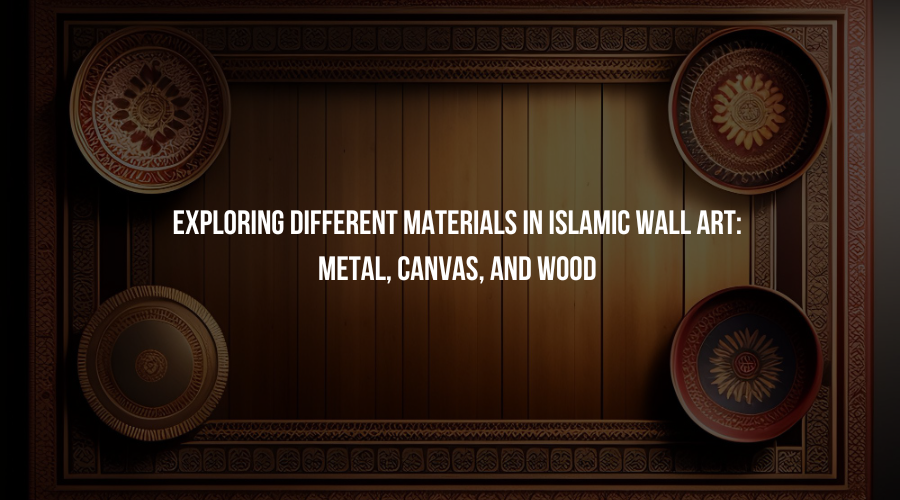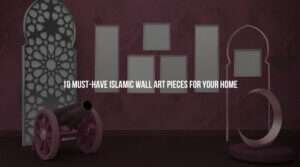Islamic wall art is a beautiful and meaningful way to decorate a Muslim home decor. It not only enhances the aesthetic appeal of a space but also serves as a constant reminder of faith, culture, and tradition. The rich history of Islamic art has given rise to various forms and materials used in creating these stunning pieces. In this blog, we will explore the different materials used in Islamic wall art, focusing on metal, canvas, and wood. Additionally, we will delve into the significance of the Kaaba Cover, known as the Kiswa, and how it influences contemporary Islamic decor.
The Beauty of Islamic Wall Art
Islamic art is characterized by its delicate patterns, geometric designs, calligraphy, and religious motifs. These elements come together to create art that is both visually appealing and spiritually uplifting. The use of different materials in Islamic wall art allows for a wide range of textures, styles, and finishes, each bringing its unique charm to a space.
Metal Islamic Wall Art
Metal wall art is a popular choice for those looking to add a touch of elegance and sophistication to your home decor. Metal pieces often feature intricate laser-cut designs that showcase the craftsmanship and attention to detail inherent in Islamic art.
Advantages of Metal Wall Art
1. Durability
Metal is a sturdy and long-lasting material, making it an excellent choice for wall art that will last for a long time.
2. Versatility
Metal Islamic wall art can be created in various finishes, including polished, matte, and brushed, allowing for versatility in design.
3. Detail
The precision of laser-cutting technology enables the creation of highly detailed and delicate designs that are characteristic of Islamic art.
Popular Metal Wall Art Designs:
1. Calligraphy
Metal wall art often features beautiful calligraphy of Quranic verses or names of Allah, adding a spiritual touch to the decor.
2. Geometric Patterns
The use of geometric patterns in metal wall art reflects the mathematical precision and symmetry found in traditional Islamic art.
3. Arabesque Designs
These intricate, flowing patterns are a staple of Islamic art and look stunning when rendered in metal.
Canvas Islamic Wall Art
Canvas is another popular material for Islamic wall art, offering a softer and more versatile medium for artistic expression. Canvas prints and paintings can range from minimalist designs to highly detailed works of art.
Advantages of Canvas Wall Art
1. Versatility
Canvas can accommodate a wide range of artistic styles, from traditional to contemporary.
2. Texture
The texture of the canvas adds depth and dimension to the Islamic work, enhancing its visual appeal.
3. Accessibility
Canvas art is widely available and can be customized to suit your choices and preferences.
Popular Canvas Wall Art Designs
1. Calligraphy
Just like metal, canvas is an excellent medium for Islamic calligraphy, allowing for both bold and subtle expressions of faith.
2. Abstract Art
Abstract interpretations of Islamic patterns and motifs can create a modern and sophisticated look in any room.
3. Kiswa-Inspired Designs
The Kiswa, or Kaaba Cover, is a black silk and gold-embroidered cloth that drapes the Kaaba in Mecca. Canvas art inspired by the Kiswa often features similar colors and patterns, making it a meaningful addition to a Muslim home.
Wood Islamic Wall Art
Wooden wall art brings warmth and a natural element to Islamic decor. The use of wood in Islamic art has a long history, with many traditional pieces featuring intricate carvings and inlays.
Advantages of Wood Wall Art
1. Natural Beauty
The natural grain and texture of wood add a unique and organic touch to the artwork.
2. Craftsmanship
Woodworking allows for detailed carvings and delicate designs that showcase the skill of the artisan.
3. Warmth
Wood wall art can create a cozy and inviting atmosphere in a home.
Popular Wood Wall Art Designs:
1. Carved Calligraphy
Wooden pieces featuring carved Quranic verses or Arabic calligraphy add a timeless and classic element to any space.
2. Geometric Patterns
Wooden art with geometric patterns can range from simple to highly intricate, reflecting the complexity of Islamic design.
3. Arabesque Designs
The flowing, interlaced patterns of Arabesque designs are beautifully rendered in wood, creating a piece that is both elegant and traditional.
The Significance of the Kiswa in Islamic Decor
The Kiswa, also known as the Kaaba Cover, holds immense significance in Islamic culture. Every year, a new Kiswa is made and placed over the holy Kaaba during the Hajj pilgrimage.
The Kiswa’s design and colors have inspired countless pieces of Islamic wall art and Muslim home decor. The use of black and gold in Islamic wall art often draws inspiration from the Kiswa, symbolizing the sacredness and reverence associated with the Kaaba.
Incorporating Kiswa-Inspired Art into Your Home
Incorporating Kiswa-inspired art into your Muslim home decor can create a connection to the holy sites and the spiritual journey of Hajj. Here are a few ideas:
1. Canvas Prints
Look for canvas prints that feature designs inspired by the Kiswa, such as black backgrounds with gold calligraphy or patterns.
2. Metal Art
Metal wall art with gold accents on a black base can evoke the look and feel of the Kiswa, adding a touch of elegance and spirituality to your decor.
3. Wooden Pieces
Wooden wall art with gold inlays or carvings inspired by the patterns and verses on the Kiswa can bring a timeless and sacred element to your home.
Choosing the Best Islamic Wall Art for Your Home
When selecting Islamic wall art, it’s essential to consider the overall theme and style of your home. Here are a few tips to help you choose the perfect wall art:
1. Consider the Space
Think about where you will place the art and how it will fit into the existing decor. Large, bold pieces can make a statement in a living room, while smaller, more intricate designs may be better suited for a bedroom or study.
2. Mix and Match
Don’t be afraid to mix different materials and designs. Combining metal, canvas, and wood art can create a dynamic and layered look.
3. Personal Connection
Choose pieces that resonate with you personally. Whether it’s a specific Quranic verse, a pattern that reminds you of your heritage, or a design inspired by the Kiswa, personal connection adds meaning to the decor.
Conclusion
Islamic wall art is a beautiful way to incorporate faith, culture, and tradition into your home decor. Whether you prefer the elegance of metal, the versatility of canvas, or the warmth of wood, there are countless options to suit your style and preferences. By understanding the significance of different materials and drawing inspiration from iconic elements like the Kiswa, you can create a space that is both visually stunning and spiritually uplifting. Embrace the rich heritage of Islamic art and let it transform your home into a sanctuary of beauty and faith.




